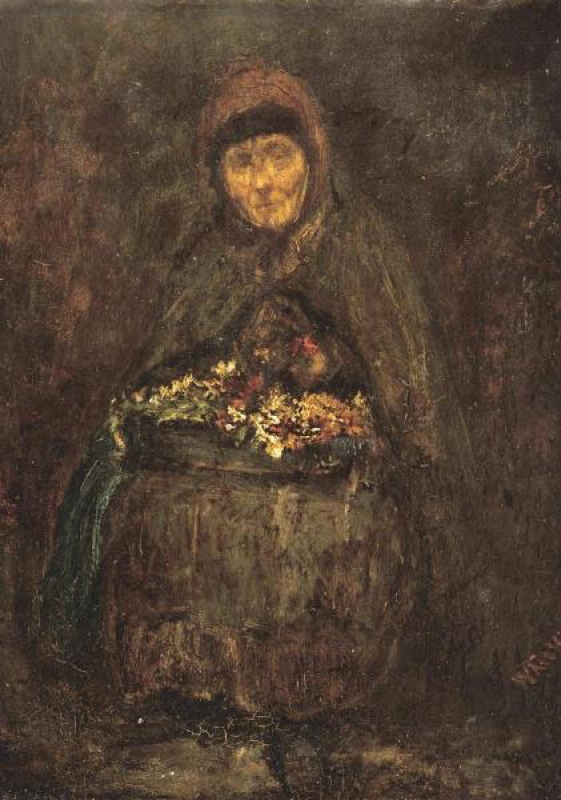Home > Catalogue > Browse > La Mère Gérard (2) << >>
Titles
Whistler's original title is not known. The sole title (though with varying accents) is as follows:
The number '2' was added in the 1980 catalogue raisonné to distinguish this painting from the other known oil portrait of the sitter. 'La Mère Gérard (2)' is the preferred title.
Description
A figure study in vertical format. An old woman is shown seated, facing the viewer. Her head is slightly tilted to her right, and her face is lined and worn. She wears a black bonnet under a plum coloured kerchief, a dark blueish-green shawl tied below her collar, and a grey skirt. In her lap is a shallow basket overflowing with white, pink and cream flowers, possibly violets, pansies and cyclamen. The ground and background are dark grey and brown.
Sitter
Mère Gérard (fl. 1810-1860). She is shown as a flower seller, which was, at this time, one of her occupations.
She posed for several portraits including La Mère Gérard (1) [YMSM 026].
There is no evidence to connect La Mère Gérard (2) with the copy Whistler is said to have made of the original portrait of Mère Gérard (La Mère Gérard (1) [YMSM 026]).
Whistler's friend, the sculptor Charles L. Drouet (1836-1908), informed the Pennells that he believed a third portrait of the sitter once existed, but it had vanished by 1908 and there is no other evidence to support Drouet's claim. 3
Comments
This is one of many studies by Whistler of elderly women, which include drawings such as Standing figure of an old woman [M.0275], and etchings such as La Rétameuse [26], La Vieille aux Loques [27].
The subject of the flower-seller was popular in nineteenth-century art. It can be read as a reflection on the economic conditions of contemporary artists.
Phyllis Sobieski compared Whistler's painting to the work of Rembrandt Harmens van Rijn (1617-1681):
'Only Gérard's face is illuminated, her lap of flowers sharing the light. Like Rembrandt, whom Whistler admired, Whistler's source of light is placed behind the subject, effecting a glow which seemingly comes from within. Whistler's handling is extraordinarily gentle. Care-worn, gaunt, almost ascetic, the slanted eyes peer out, almost unseeing; an aquiline nose, winter's ruddy cheeks, high cheekbones, all are drawn with a most caring hand.' 4
Last updated: 25th November 2020 by Margaret







